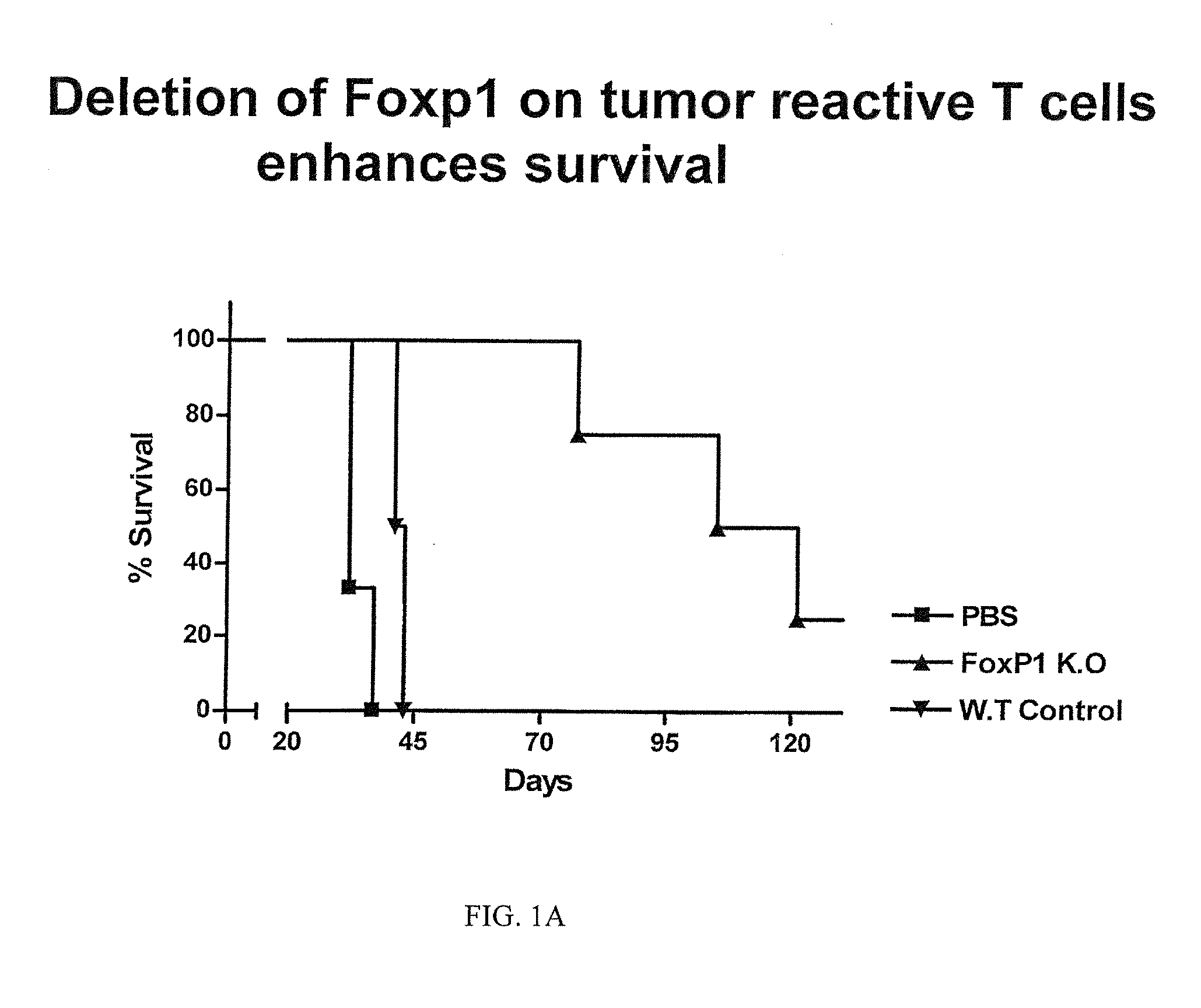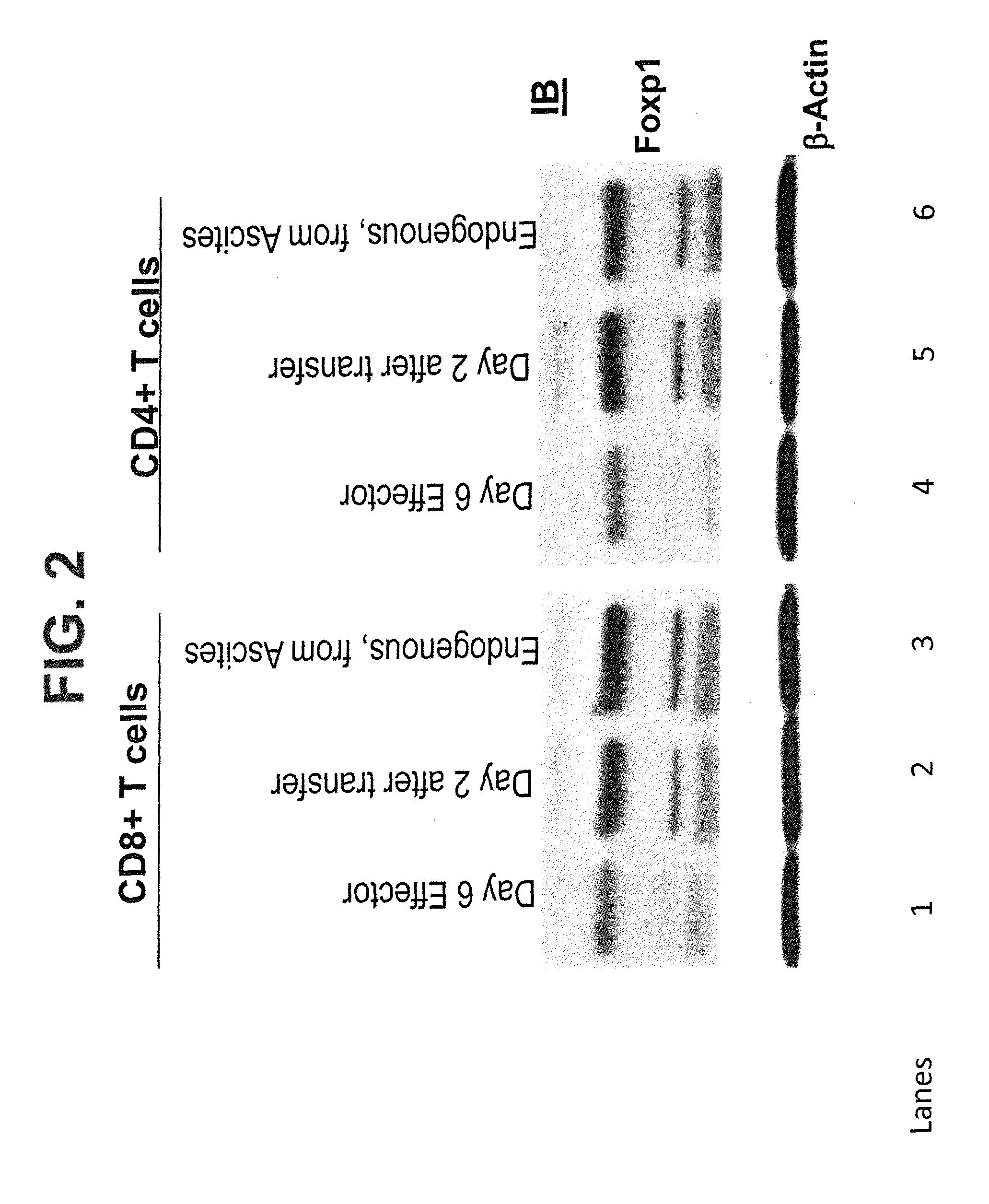Methods and Compositions for Enhancing the Therapeutic Effect of Anti-Tumor T Cells
a technology of t cell therapy and composition, which is applied in the direction of cancer antigen ingredients, dna/rna fragmentation, viruses, etc., can solve the problems of ineffective antitumor response release mechanisms, inability to effectively release antitumor brake mechanisms, and inability to effectively remove antitumor brake mechanisms, etc., to achieve the effect of enhancing the anti-tumor respons
- Summary
- Abstract
- Description
- Claims
- Application Information
AI Technical Summary
Benefits of technology
Problems solved by technology
Method used
Image
Examples
example 1
Identification of a New Mechanism of T Cell Quiescence Mediated for Foxp1
[0102]We have identified a new mechanism of T cell quiescence mediated by Foxp1, as discussed in Feng, X et al, 2011 Nature Immunol., 12:544-550, incorporated by reference herein. Our data also demonstrate that through negative regulation of IL-7 receptor α-chain (IL-7Rα) expression and T cell receptor (TCR) signaling, Foxp1 is critical in maintaining mature T cell quiescence. Correspondingly, acute deletion of Foxp1 (all four isoforms) allows mature naive CD8+ T cells to gain effector phenotypes / functions and to directly proliferate in response to IL-7.
[0103]A. Foxp1-Deficient Naive CD8+ T Cells Proliferate in Response to IL-7
[0104]To study Foxp1 function in mature T cells, we generated Foxp1f / fCre-ERT2+RosaYFP mice in which Cre recombinase becomes activated by treatment with tamoxifen and Cre induces deletion of loxP flanked Foxp1 alleles (Foxp1f / f) and the expression of yellow fluorescent protein (YFP) as a ...
example 2
Wild-Type Tumor-Associated T Cells Up-Regulate Foxp1 mRNA as Tumor Progresses
[0121]In addition, we have demonstrated that tumor-associated T cells up-regulate Foxp1 mRNA as tumor progresses in preclinical models of established ovarian carcinoma.
[0122]Foxp1 mRNA was quantified by real-time PCR in adoptively transferred CD3+CD8+ T cells sorted from tumor locations at different temporal points after ID8-Vegf / Defb29 tumor challenge. Adoptively transferred effector T cells represent naïve T cells primed for 7 days against tumor antigen in vitro (Cancer Res. 2009; 69: 6331-8). These T cells were FACS-sorted from peritoneal wash samples based on the expression of a “congenic” marker (CD45.1), which is not expressed by endogenous (non-transferred, CD45.2) T cells. Relative mRNA expression was standardized by GAPDH mRNA.
[0123]Immersed in ovarian tumor masses, it is likely that the potential repeated tumor antigen stimulation, plus the presence of regulatory dendritic cells (DCs) and alternat...
example 3
Tumor-Reactive Foxp1-Deficient T Cells Exert Superior Therapeutic Effects Compared to Wild-Type T Cells
[0124]To further determine the role of Foxp1, we treated a preclinical mouse model of established ovarian carcinoma, i.e., ID8-Defb29 / Vegf-a ovarian carcinoma bearing mice, as described in Conejo-Garcia J R, et al, 2004 Nat Med, 10(9):950-8 and Cubillos-Ruiz J R, et al, 2009 J. Clin. Invest., 119(8):2231-44). In this study, mice express a congenic marker (CD45.1), to allow distinguishing adoptively transferred from endogenous T cells in subsequent experiments.
[0125]Anti-tumor T cells were negatively immune purified from the spleens of naïve (non tumor-bearing) mice, which were either Foxp1-deficient (Foxp1f / f) or wild-type (Foxp1f / +). These mice strains are generated as described in Feng, X et al, 2010 Blood, 115(3):510-518, incorporated herein by reference. Both classes of T cells were then primed for 7 days against tumor antigens derived from resected ovarian tumors of the mouse ...
PUM
| Property | Measurement | Unit |
|---|---|---|
| Therapeutic | aaaaa | aaaaa |
Abstract
Description
Claims
Application Information
 Login to View More
Login to View More - R&D
- Intellectual Property
- Life Sciences
- Materials
- Tech Scout
- Unparalleled Data Quality
- Higher Quality Content
- 60% Fewer Hallucinations
Browse by: Latest US Patents, China's latest patents, Technical Efficacy Thesaurus, Application Domain, Technology Topic, Popular Technical Reports.
© 2025 PatSnap. All rights reserved.Legal|Privacy policy|Modern Slavery Act Transparency Statement|Sitemap|About US| Contact US: help@patsnap.com



